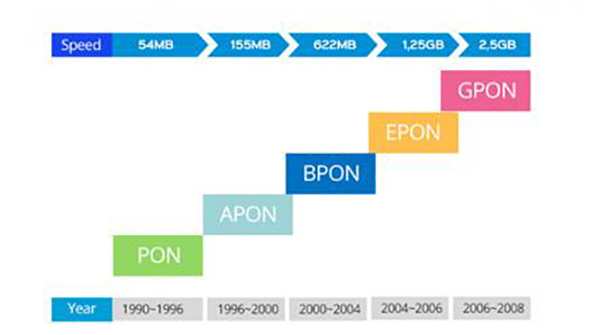What is PON Technology?
PON is the abbreviation of Passive Optical Network. It is a very important
type of optical fiber access system, occupying a dominant position in the
access market. PON technology only uses optical fibers and passive components (such as PON
splitters and combiners), and does not use active components such as
amplifiers, repeaters, or shaping circuits. According to different PON
terminals, the network system can be divided into fiber to the home (FTTH),
fiber to the curb (FTTC), fiber to the building (FTTB), etc.
Types of PON Technology
APON
APON is the abbreviation of Asynchronous Transmission Mode Passive Optical Network. APON technology is based on the ATM protocol, also called ATMPON. APON rate comply 155Mbps and ITU-T G.983 standard. APON
is the original PON technology system used for commercial deployment. With the rapid development of Ethernet technology, APON technology is basically no longer used.
BPON
BPON is the abbreviation of Broadband Passive Optical Networks. BPON is an enhancement after the APON standard. BPON uplink and downlink speeds of 155Mbps and 1.25Gbps respectively. It
also adds functions such as dynamic bandwidth allocation and protection, and
can provide services such as Ethernet access, video transmission, and
high-speed leased lines. The disadvantage of BPON is that its bandwidth and coverage are limited during long-distance transmission. Its capacity is small because of limited by optical loss and splitting ratio of the optical splitter.
GPON
GPON is the abbreviation of Gigabit Passive Optical Networks. GPON
supports various transmission rates of the same protocol. The laser with a
wavelength of 1490 nm transmits downstream data, while the upstream data is
transmitted at a wavelength of 1310 nm. The maximum downlink data rate is 2.5
Gbps, and the maximum uplink data rate is 1.25 Gbps. GPON sends downlink broadcast packets, and GPONS uplink TDMA (time division multiplexing) mode. The GPON network mainly consists of OLT (optical line terminal), ODN (optical distribution network) and ONU (optical network unit).
The GPON technology has many advantages such as high bandwidth, high efficiency, large coverage, and rich user interfaces. GPON is an ideal technology for broadband and comprehensive transformation of network access services. Gpon is used more and more widely.
EPON
EPON is the abbreviation of Ethernet Passive Optical Networks. EPON technology
provides a bidirectional 1 GB/s link. The downlink uses a 1490nm wavelength,
and the uplink uses a 1310nm wavelength. The 1550nm wavelength is reserved for
future expansion or additional services. The original line data rate in both
the upstream and downstream directions is 1.25 GB/s. With the advantages of
scalability, simplicity, multicast convenience, and full-service access
capabilities, EPON is used in networks in many regions of Asia. EPON main advantage is its economic, the network cost is low based on EPON technology.

Advantages of PON Technology
They use existing optical fibers, their deployment costs are lower, maintenance is simple, scalability is flexible, and they are easy to upgrade.
The PON network is not susceptible to electromagnetic interference and noise, and can maintain signal integrity.
PON can provide a wide range of services to a large number of users.
Disadvantages of PON
They need extensive fiber deployment.
Due to the amount of management traffic overhead transmitted from the
central office to a single customer ONU, larger networks may become less efficient.
PON must comply with strict transmission distance restrictions.
Conclusion
The article tell us what is pon technology and the advantages and disadvantages of different PON.
As the demand for faster Internet services and more videos grows, PON is
becoming more and more popular. EPON and GPON are currently the most commonly
deployed PON systems. PON network is undoubtedly an effective solution for
multiple network users. As people have been seeking a higher bandwidth supply,
so in the near future, the transmission capacity will be greatly improved.
Related Link:
What is APON, BPON, EPON, GPON
Difference between GEPON and GPON
Baudcom offers all types of PON related products. For more information, please visit Baudcom.